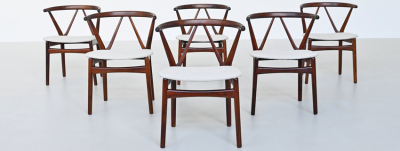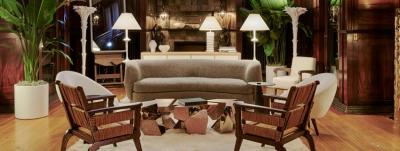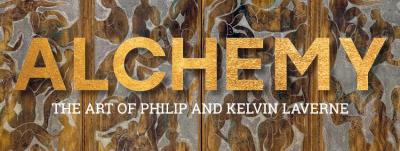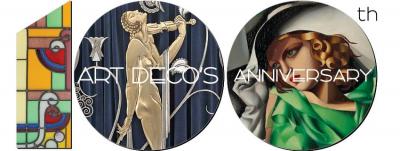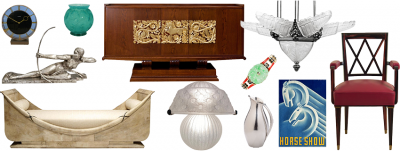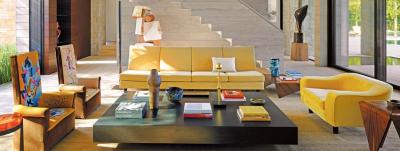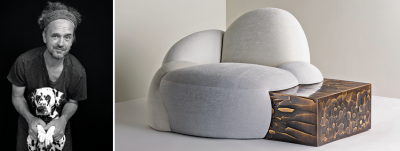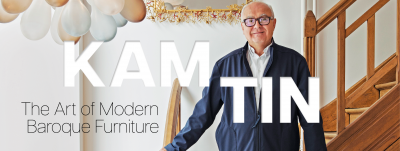Detrich American Foundation: A Compass Bottom’d Chair
 |
By the time of his death in early 1929, the Philadelphia wool merchant Howard Reifsnyder’s collection was well known in the field of American decorative arts, made possible through a number of means. He provided scholarly access to his collection at his 3914 Walnut Street residence in West Philadelphia; and he made loans of numerous objects to the Pennsylvania Museum (now the Philadelphia Museum of Art) and to the historic house it administered in East Fairmount Park, Mount Pleasant. The sale of his collection by American Art Galleries during four days in April 1929, months before the stock market crash that year, was a momentous success, with stunning prices achieved that would be unmatched for decades. In the catalogue of the sale, three Philadelphia compassed side chairs with blocked front rails with shells carved in the center of the rails were listed as lot numbers 653, 654, and 655. The chairs were represented as being from the same set and were illustrated together, though they were sold individually (Fig.1). On account of the publicity the sale received, along with the spirited and competitive bidding during the sale, the three chairs were each given the soubriquet “Reifsnyder chair.” Over time, any Philadelphia compassed chair with blocked front seat rails from any set came to be referred to as a “Reifsnyder chair.”
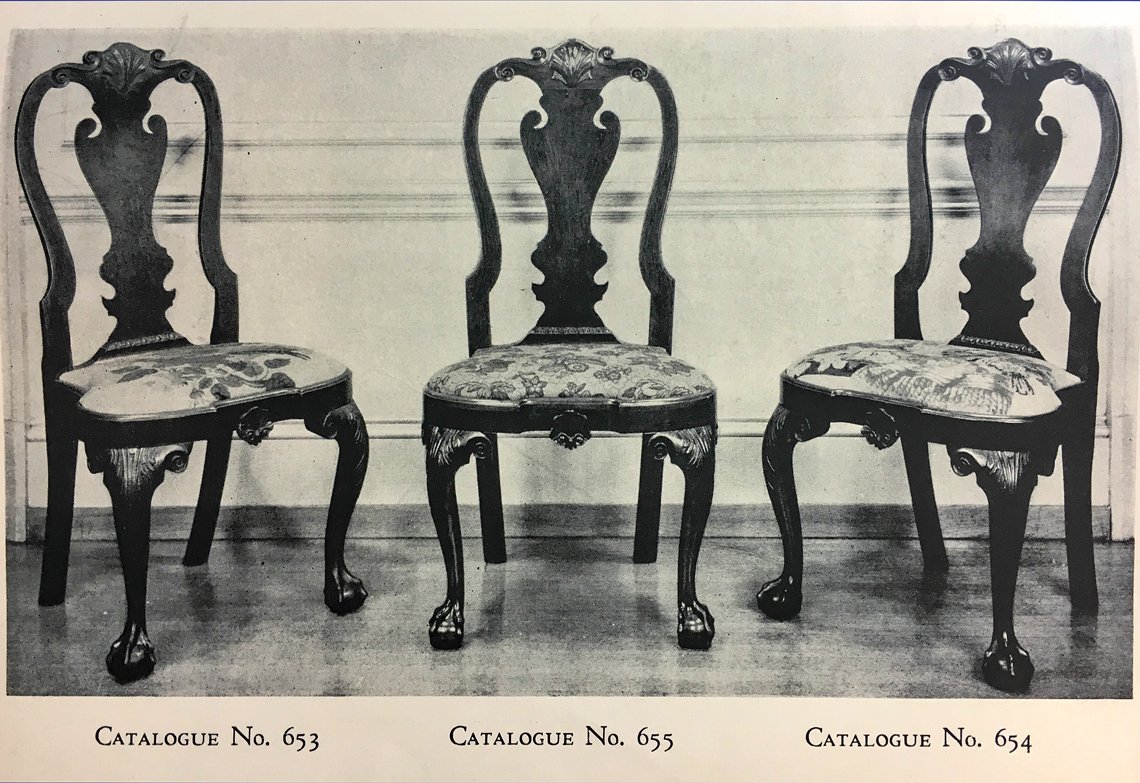 |
Fig. 1: The “Reifsnyder chairs,” lots 653-655. Colonial Furniture, The Superb Collection of The Late Howard Reifsnyder. Catalogue, American Art Association, Inc. 1929. |
 |
Fig. 2: Side chair. Philadelphia, Pa., ca. 1750. Black walnut, hard pine. H. 42, W. 19¾, D. 21 in. The Dietrich American Foundation. The seat covering is a modern watered moreen fabric from Eaton Hill Textile Works, Marshfield, Vt. |
A black walnut side chair in the collection of the Dietrich American Foundation is one of four extant chairs from another mid-eighteenth-century set of Philadelphia compassed side chairs—referred to in the period as “compass bottom’d”—also distinguished by blocked front seat rails containing shells (Fig. 2). While researching objects related to the Foundation’s chair, we documented five closely related sets of side chairs with the distinguishing feature of blocked front rails. The chairs in all five sets have compassed backs and seats, blocked front seat rails with a carved shell, shells and volutes carved on the crest rail, carving on the knees, and solid, S-curved back splats. Variations among the sets include the choice of trifid or claw and ball feet and rear stiles with flat or rounded faces. Three of the sets have egg and tongue pattern carving on the ovolo element of the plinth supporting the splat.
The construction of the chairs in all five sets is similar and closely follows that of the majority of compassed chair made in Philadelphia during the middle of the eighteenth century. The front and side seat rail boards are oriented horizontally. The side seat rails are tenoned to the front seat rail and tenoned through the rear stiles and wedged. The rear set rail is tenoned to the rear stiles and the joints are double pegged. The front legs are attached to the seat rails with round tenons cut at the back corner of the top of the legs and fit to holes bored in the seat frame. The rear stiles have laminations for width at both the inside and outside curves. The laminations are often, but not always, the pieces cut from the stiles while creating the curved outline. The stiles are tenoned to the crest rail. The splat pedestal is nailed and glued to the rear seat rail. The splat is tenoned to the pedestal and crest rail. Unlike many compassed chairs made in Philadelphia, on the Dietrich Foundation’s chair, the moulding on the front and side seat rails that retains the loose seat, is carved from the solid timber of the seat rails rather than having been cut from an oversized, assembled loose seat frame. The different sets are interestingly inconsistent in the way this element is handled. One other set has the moulding carved from the solid rails. On three sets, the moulding on the front rail is carved from the solid and the side mouldings are applied. The front and side mouldings on the Reifsnyder set are applied.
During the survey of the Foundation’s side chair, numerous examples of chairs from four of the related sets, including the set the Foundation’s chair belonged to, were found throughout the available auction house records, antique dealer advertisements, and scholarly publications. However, we were intrigued to discover none of the three chairs from the Reifsnyder catalogue had appeared in the marketplace since 1929, nor had they been published since. Locating their whereabouts became a challenge to the survey team.
A singular design feature not seen in any of the other four sets that distinguishes the chairs in the Reifsnyder catalogue is the design of the shell on the crest. There are six convex and five concave lobes with a concave lobe at the center. The common design of pecten shells on eighteenth-century Philadelphia furniture consists of five convex lobes and four concave lobes with a central convex lobe (Fig. 3). This fact helped us determine that the true “Reifsnyder chairs” did not belong to any of the four sets of related chairs.
 | 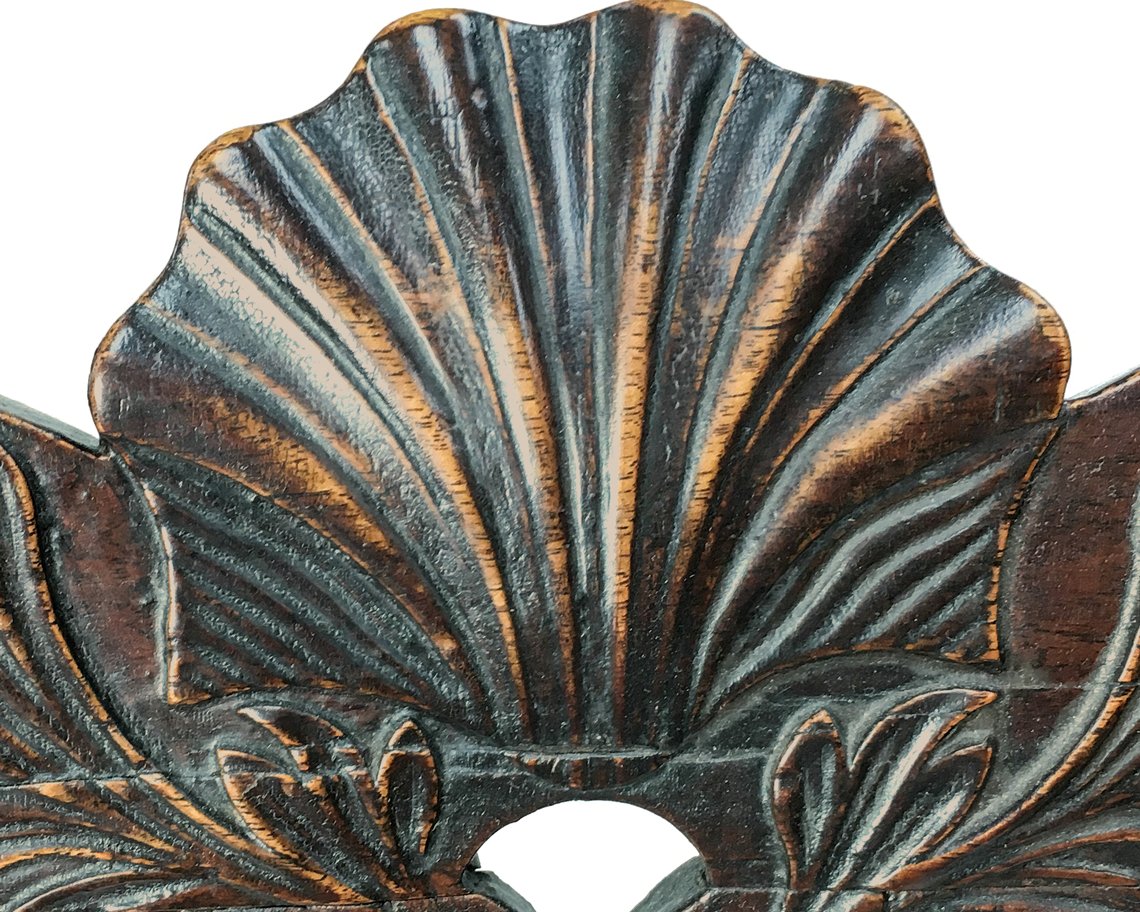 | |
Fig. 3: Left: The most common design of pecten shells found on eighteenth-century Philadelphia furniture with five convex lobes and four concave lobes. Right: The design of the shells found on the Reifsnyder chairs with six convex and five concave lobes with a concave lobe at the center. Both chairs, the Dietrich American Foundation. | ||
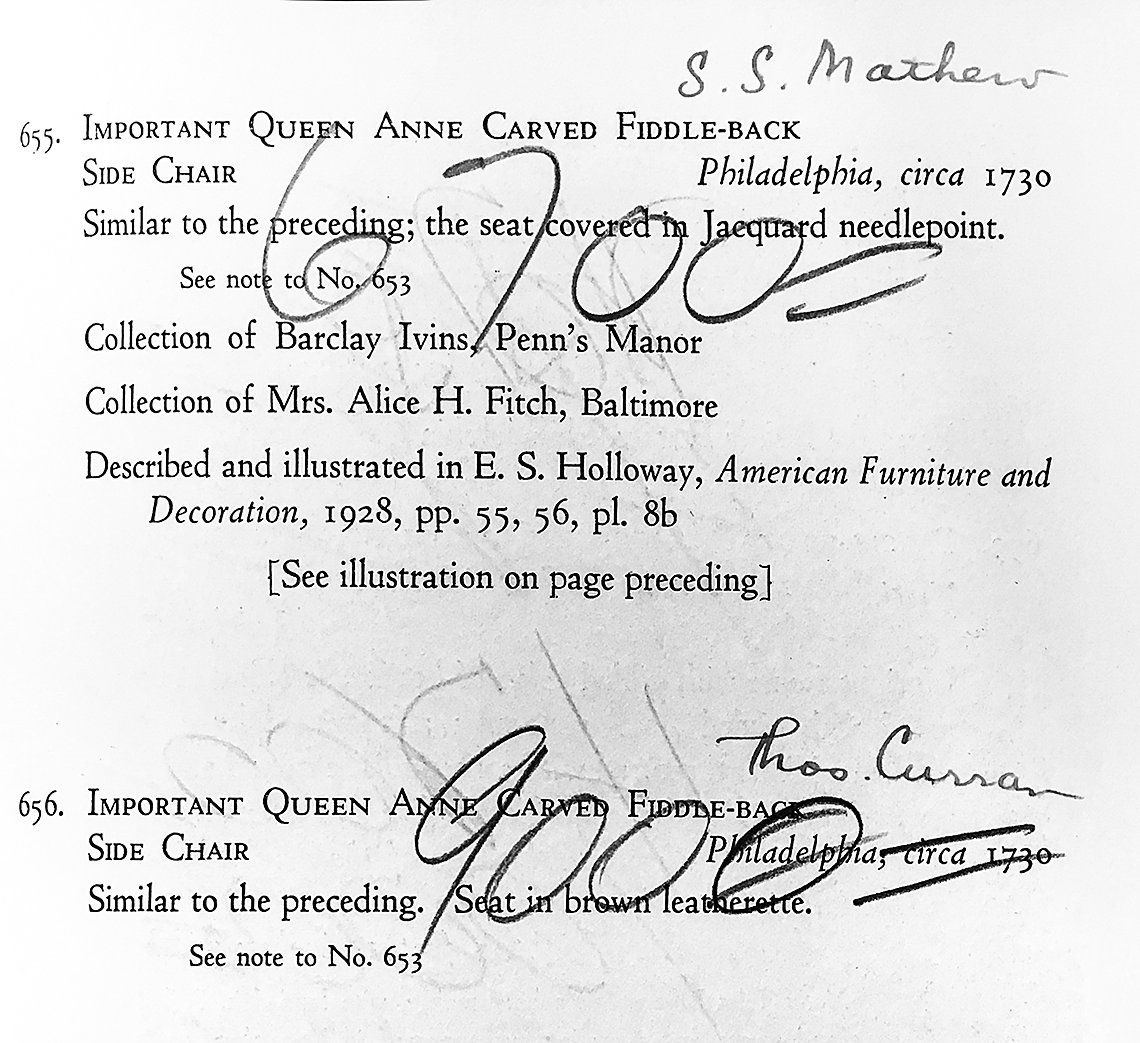 | 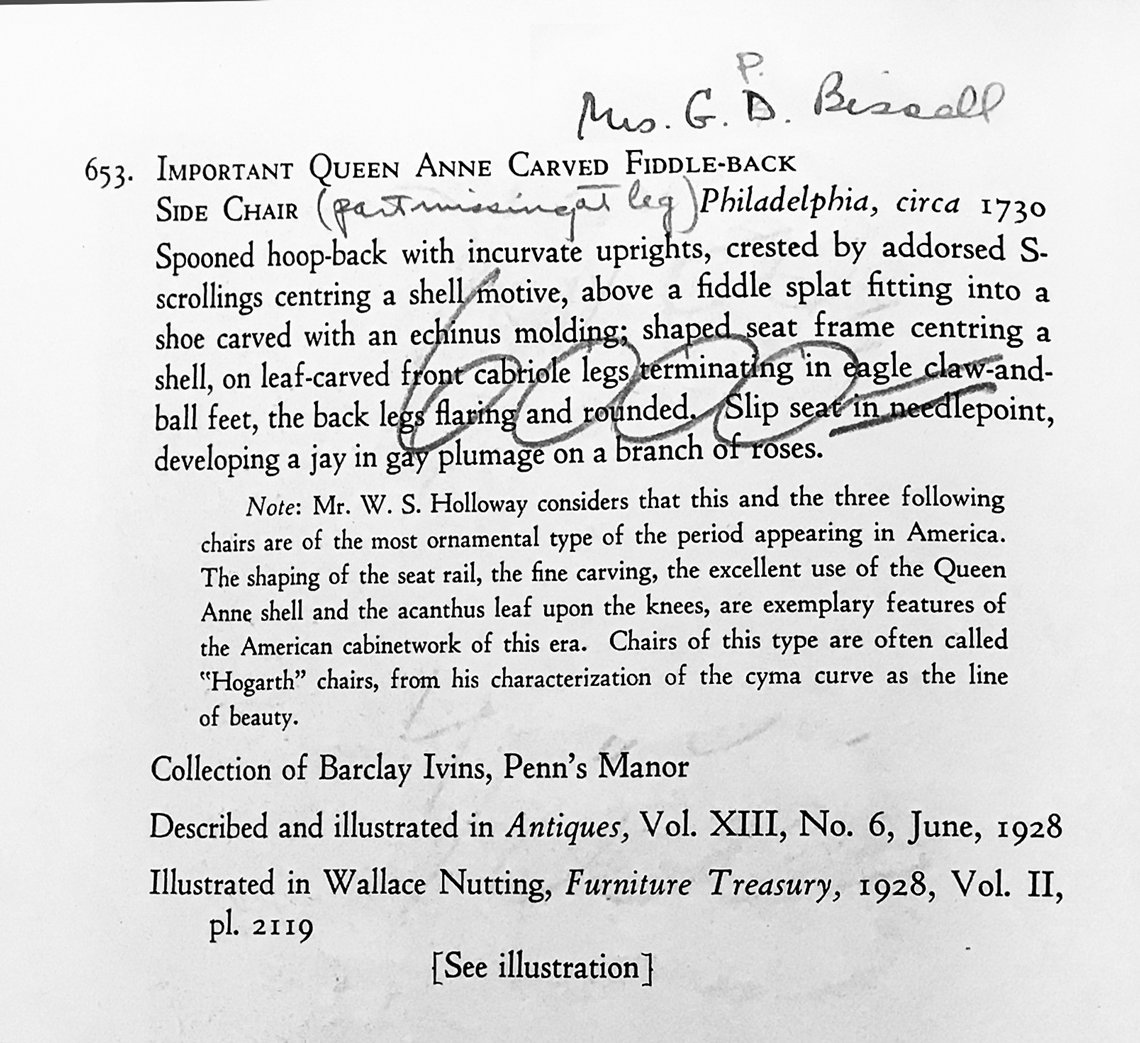 | |
Fig. 4, left: “S. S. Mathew.” Annotated inscription for lot 655 in Colonial Furniture, The Superb Collection of The Late Howard Reifsnyder. American Art Association, Inc. 1929. Fig. 5, right: “Mrs. P. Bissell.” Annotated inscription for lot 653 in Colonial Furniture, The Superb Collection of The Late Howard Reifsnyder. American Art Association, Inc. 1929. | ||
We found that the three Reifsnyder chairs descended in the families of the original purchasers and now reside in public collections. In 1997, two of the chairs purchased by Matthew Scott Sloan (1881–1951) at the sale, entered the collection of the Brooklyn Museum, as a gift of his daughter Lidie Lane Sloan McBurney (1914–1996). The Reifsnyder provenance for the chairs is not mentioned on the museum’s website, but in an annotated copy of the Reifsnyder sale catalogue, “S. S. Mathew” is noted as the buyer of lot 655 (Fig. 4). In articles before the Reifsnyder sale and in the catalogue of the sale, the chairs were described as being made of black walnut, but the two chairs in the Brooklyn Museum are made of black cherry, a rare use of that wood species in high style Philadelphia chairs made during the middle of the eighteenth century. Locating the third chair proved to be more elusive. But several years after the survey and treatment of the Dietrich American Foundation side chair had been completed, I was surprised to come upon a black cherry Philadelphia compassed side chair with a blocked front identical to the chairs in the Brooklyn Museum during a tour of the new Leslie P. and George H. Hume American Furniture Study Center. It had recently arrived and had not yet found a home in the racks of chair storage at the Center. When the chair went up on the Yale University Art Gallery’s website several months later, it was listed as having been given to the Gallery in 2018 by Julie and Ted Leisenring, B.A. 1949. The provenance cites Howard Reifsnyder as a previous owner of the chair and specifies that lot 653 in the Reifsnyder catalogue was sold to Julia du Pont Andrews Bissell (1907–1994) and Alfred E. Bissell, Wilmington, Delaware. In the annotated catalogue the chair is noted as being purchased by “Mrs. P. Bissell” (Fig. 5). The three “Reifsnyder chairs” were now accounted for.
While discerning the disposition and current location of the three chairs in the Reifsnyder catalogue might be thought to be peripheral to the study of the side chair in the collection of the Dietrich American Foundation, it hints at the many other intriguing discoveries that were made during the furniture survey and how this work has contributed to the history of furniture making in colonial America.
This article is the fourth in a series featuring the Dietrich American Foundation’s collection, with an eye toward presenting the collection’s strength in furniture. We are delighted to present these articles as a type of crowd sourcing exercise, where responses and information shared by readers can inform the research. New information gleaned will be provided over the course of the series. As is always the Foundation’s mission, we are excited to share findings and stories about people, places, and history that are revealed through our research. Contact details are in the author bio below. For information about the Dietrich American Foundation, visit dietrichamericanfoundation.org.
1. Besides the Foundation’s and the Reifsnyder sets, the other sets are represented by the following single chairs, 1. https://www.sothebys.com/en/auctions/ecatalogue/2017/americana-collection-george-s-parker-ii-caxambas-foundation-n09605/lot.2084.html, 2. https://www.christies.com/lot/lot-the-powel-griffitts-family-queen-anne-carved-walnut-6188145/?from=salesummary&intObjectID=6188145&lid=1 3. https://www.christies.com/en/lot/lot-6097333.
2. For a discussion on the construction of Philadelphia compassed chairs, see Alan Miller, “Flux in Design in Early Eighteenth-Century Philadelphia Furniture, American Furniture, 2014, Ed. Luke Beckerdite, Milwaukee, WI.
3. The Brooklyn Museum chairs can be accessed here: https://www.brooklynmuseum.org/opencollection/objects/2401.
4. The Yale University Art Gallery chair can be accessed here: https://artgallery.yale.edu/collections/objects/276831. A fourth chair from this set was bequeathed to the Metropolitan Museum of Art in 2016: https://www.metmuseum.org/art/collection/search/20587?searchField=All&sortBy=Relevance&ft=2016.797.12&offset=0&rpp=20&pos=1.
Christopher Storb is a furniture conservator, woodworking historian, and wood artist. Please send comments and related research to cstorb@gmail.com, or call 610.212.5528.
This article was originally published in the Summer 2021 issue of Antiques & Fine Art magazine, a fully digitized version of which is available at www.afamag.com. AFA is affiliated with Incollect.com.
 |















